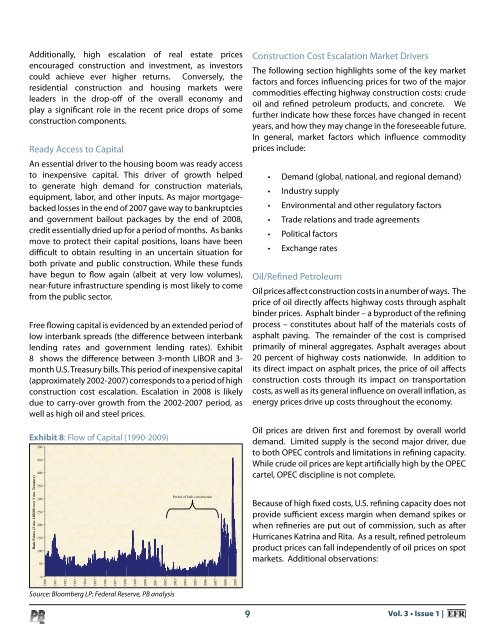Volume 3 Issue 1.indd - Parsons Brinckerhoff
Volume 3 Issue 1.indd - Parsons Brinckerhoff
Volume 3 Issue 1.indd - Parsons Brinckerhoff
Create successful ePaper yourself
Turn your PDF publications into a flip-book with our unique Google optimized e-Paper software.
Additionally, high escalation of real estate prices<br />
encouraged construction and investment, as investors<br />
could achieve ever higher returns. Conversely, the<br />
residential construction and housing markets were<br />
leaders in the drop-off of the overall economy and<br />
play a significant role in the recent price drops of some<br />
construction components.<br />
Ready Access to Capital<br />
An essential driver to the housing boom was ready access<br />
to inexpensive capital. This driver of growth helped<br />
to generate high demand for construction materials,<br />
equipment, labor, and other inputs. As major mortgagebacked<br />
losses in the end of 2007 gave way to bankruptcies<br />
and government bailout packages by the end of 2008,<br />
credit essentially dried up for a period of months. As banks<br />
move to protect their capital positions, loans have been<br />
difficult to obtain resulting in an uncertain situation for<br />
both private and public construction. While these funds<br />
have begun to flow again (albeit at very low volumes),<br />
near-future infrastructure spending is most likely to come<br />
from the public sector.<br />
Free flowing capital is evidenced by an extended period of<br />
low interbank spreads (the difference between interbank<br />
lending rates and government lending rates). Exhibit<br />
8 shows the difference between 3-month LIBOR and 3-<br />
month U.S. Treasury bills. This period of inexpensive capital<br />
(approximately 2002-2007) corresponds to a period of high<br />
construction cost escalation. Escalation in 2008 is likely<br />
due to carry-over growth from the 2002-2007 period, as<br />
well as high oil and steel prices.<br />
Exhibit 8: Flow of Capital (1990-2009)<br />
Basis Points (3 mo. LIBOR over 3 mo. Treasury)<br />
500<br />
450<br />
400<br />
350<br />
300<br />
250<br />
200<br />
150<br />
100<br />
50<br />
Period of high construction<br />
Construction Cost Escalation Market Drivers<br />
The following section highlights some of the key market<br />
factors and forces influencing prices for two of the major<br />
commodities effecting highway construction costs: crude<br />
oil and refined petroleum products, and concrete. We<br />
further indicate how these forces have changed in recent<br />
years, and how they may change in the foreseeable future.<br />
In general, market factors which influence commodity<br />
prices include:<br />
• Demand (global, national, and regional demand)<br />
• Industry supply<br />
• Environmental and other regulatory factors<br />
• Trade relations and trade agreements<br />
• Political factors<br />
• Exchange rates<br />
Oil/Refined Petroleum<br />
Oil prices affect construction costs in a number of ways. The<br />
price of oil directly affects highway costs through asphalt<br />
binder prices. Asphalt binder – a byproduct of the refining<br />
process – constitutes about half of the materials costs of<br />
asphalt paving. The remainder of the cost is comprised<br />
primarily of mineral aggregates. Asphalt averages about<br />
20 percent of highway costs nationwide. In addition to<br />
its direct impact on asphalt prices, the price of oil affects<br />
construction costs through its impact on transportation<br />
costs, as well as its general influence on overall inflation, as<br />
energy prices drive up costs throughout the economy.<br />
Oil prices are driven first and foremost by overall world<br />
demand. Limited supply is the second major driver, due<br />
to both OPEC controls and limitations in refining capacity.<br />
While crude oil prices are kept artificially high by the OPEC<br />
cartel, OPEC discipline is not complete.<br />
Because of high fixed costs, U.S. refining capacity does not<br />
provide sufficient excess margin when demand spikes or<br />
when refineries are put out of commission, such as after<br />
Hurricanes Katrina and Rita. As a result, refined petroleum<br />
product prices can fall independently of oil prices on spot<br />
markets. Additional observations:<br />
0<br />
1990<br />
1991<br />
1992<br />
1993<br />
1994<br />
1995<br />
1996<br />
1997<br />
1998<br />
1999<br />
2000<br />
2001<br />
2002<br />
2003<br />
2004<br />
2005<br />
2006<br />
2007<br />
2008<br />
2009<br />
Source: Bloomberg LP; Federal Reserve, PB analysis<br />
9 Vol. 3 • <strong>Issue</strong> 1 |

















